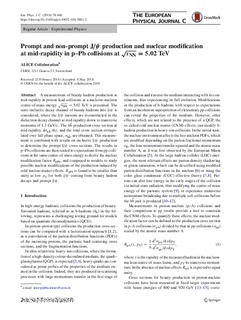Prompt and non-prompt J/ψ production and nuclear modification at mid-rapidity in p–Pb collisions at √sNN=5.02 TeV
Acharya, Shreyasi; Acosta, Fernando T.; Adamová, Dagmar; Adolfsson, Jonatan; Aggarwal, Madan M.; Agnello, Michelangelo; Agrawal, Nikita; Ahammed, Zubayer; Ahn, Sang Un; Aiola, Salvatore; Alme, Johan; Altenkaemper, Lucas; Djuvsland, Øystein; Ersdal, Magnus Rentsch; Fionda, Fiorella Maria Celeste; Nystrand, Joakim; Rehman, Attiq ur; Røhrich, Dieter; Tambave, Ganesh Jagannath; Ullaland, Kjetil; Velure, Arild; Wagner, Boris; Zhou, Zhuo; Arsene, Ionut Christian; Bätzing, Paul Christoph; Dordic, Olja; Lardeux, Antoine Xavier; Lindal, Svein; Mahmood, Sohail Musa; Richter, Matthias; Røed, Ketil; Skaali, Toralf Bernhard; Tveter, Trine Spedstad; Wikne, Jon Christopher; Zhao, Chengxin; Helstrup, Håvard; Hetland, Kristin Fanebust; Kileng, Bjarte; Nesbø, Simon Voigt; Storetvedt, Maksim Melnik; Langøy, Rune; Lien, Jørgen; Akindinov, Alexander; Al-Turany, Mohammed; Alam, Sk Noor; De Albuquerque, Danilo Silva; Aleksandrov, Dimitry; Alessandro, Bruno; Alfaro Molina, José Rubén; Ali, Yasir Turki Ben; ALICE, Collaboration
Journal article, Peer reviewed
Published version
Permanent lenke
http://hdl.handle.net/11250/2507886Utgivelsesdato
2018Metadata
Vis full innførselSamlinger
- Institutt for mikrosystemer [520]
- Publikasjoner fra CRIStin [3401]
Sammendrag
A measurement of beauty hadron production at mid-rapidity in proton-lead collisions at a nucleon–nucleon centre-of-mass energy √sNN = 5.02 TeV is presented. The semi-inclusive decay channel of beauty hadrons into J/ψ is considered, where the J/ψ mesons are reconstructed in the dielectron decay channel at mid-rapidity down to transverse momenta of 1.3 GeV/c. The bb production cross section at mid-rapidity, dσbb/dy, and the total cross section extrapolated over full phase space, σb¯b, are obtained. This measurement is combined with results on clusive J/ψ production to determine the prompt J/ψ cross sections. The results in p–Pb collisions are then scaled to expectations from pp collisions at the same centre-of-mass energy to derive the nuclear modification factor Pb, and compared to models to study possible nuclear modifications of the production induced by cold nuclear matter effects. RpPb is found to be smaller than unity at low pT for both J/ψ coming from beauty hadron decays and prompt J/ψ .

